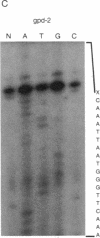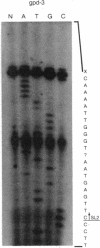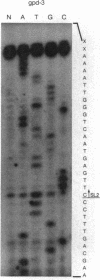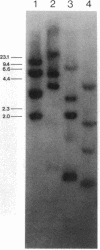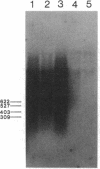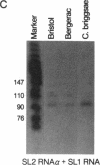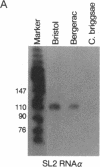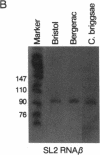Abstract
In the nematode Caenorhabditis elegans, the 22-nucleotide RNA sequence called the spliced leader (SL) is trans-spliced from the 100-nucleotide-long SL RNA to some mRNAs. We have identified a trans-spliced leader (SL2) whose sequence differs from that of the original spliced leader (SL1), although both are 22 nucleotides long. By primer-extension sequencing, SL2 but not SL1 was shown to be present at the 5' end of the mRNA encoded by one of the four glyceraldehyde-3-phosphate dehydrogenase genes. The other three glyceraldehyde-3-phosphate dehydrogenase genes encode mRNAs that have the SL1 but not the SL2 sequence at their 5' ends. Therefore, the trans-splicing process can discriminate the transfer of SL1 from that of SL2 in a gene-specific manner.
Full text
PDF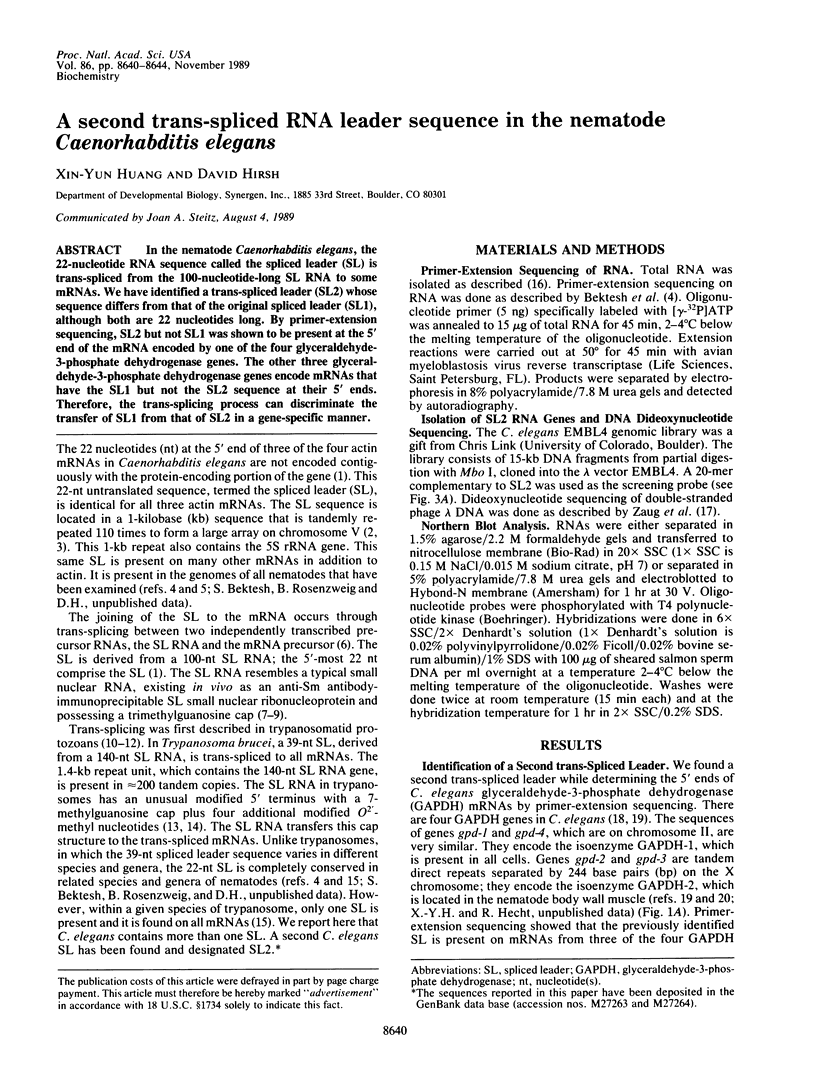
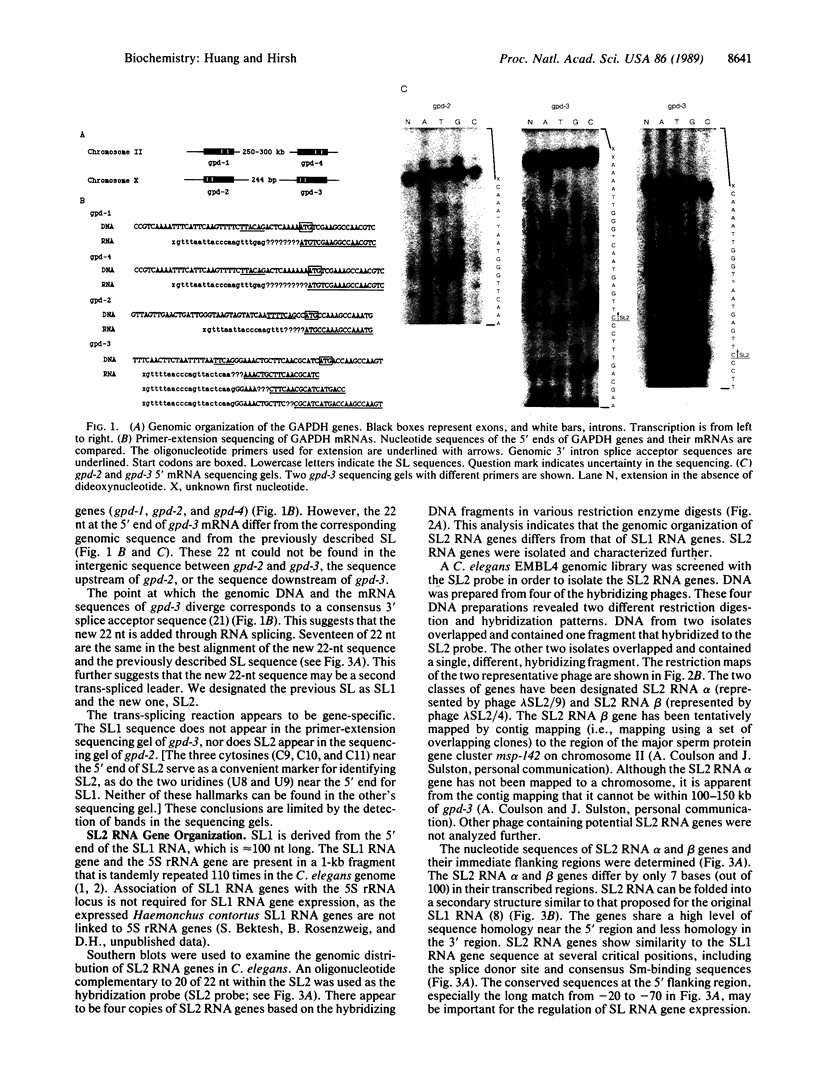
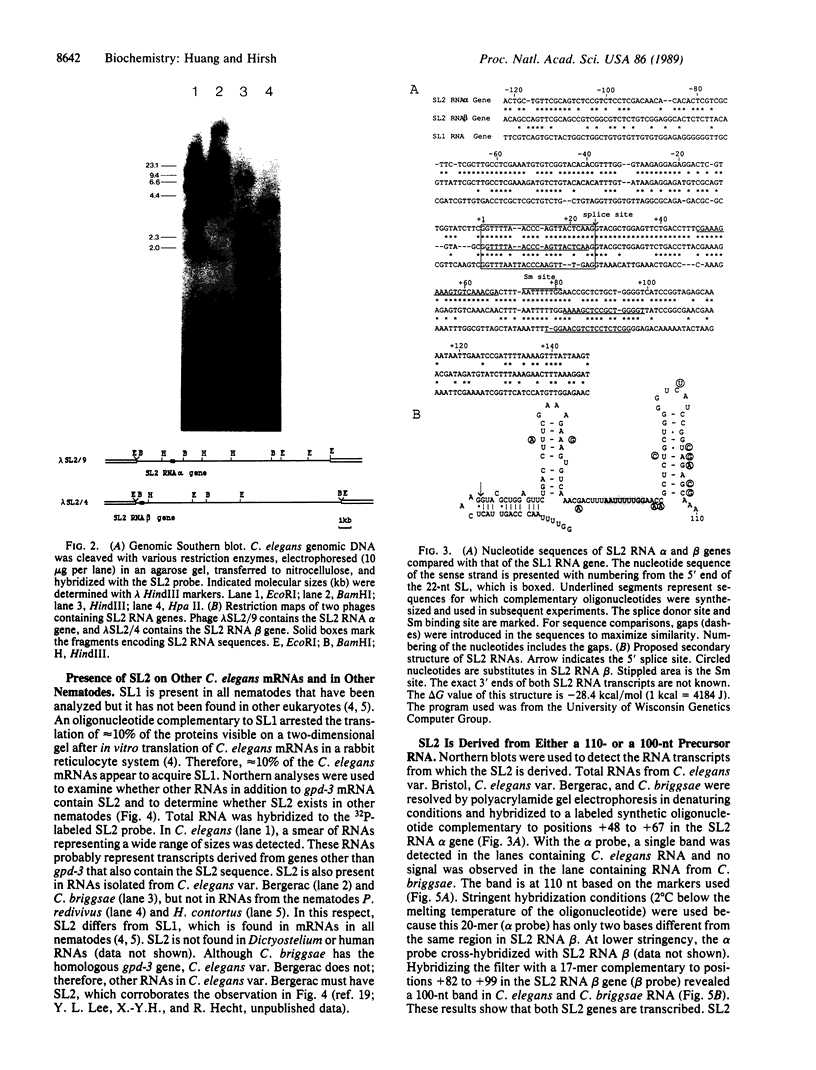
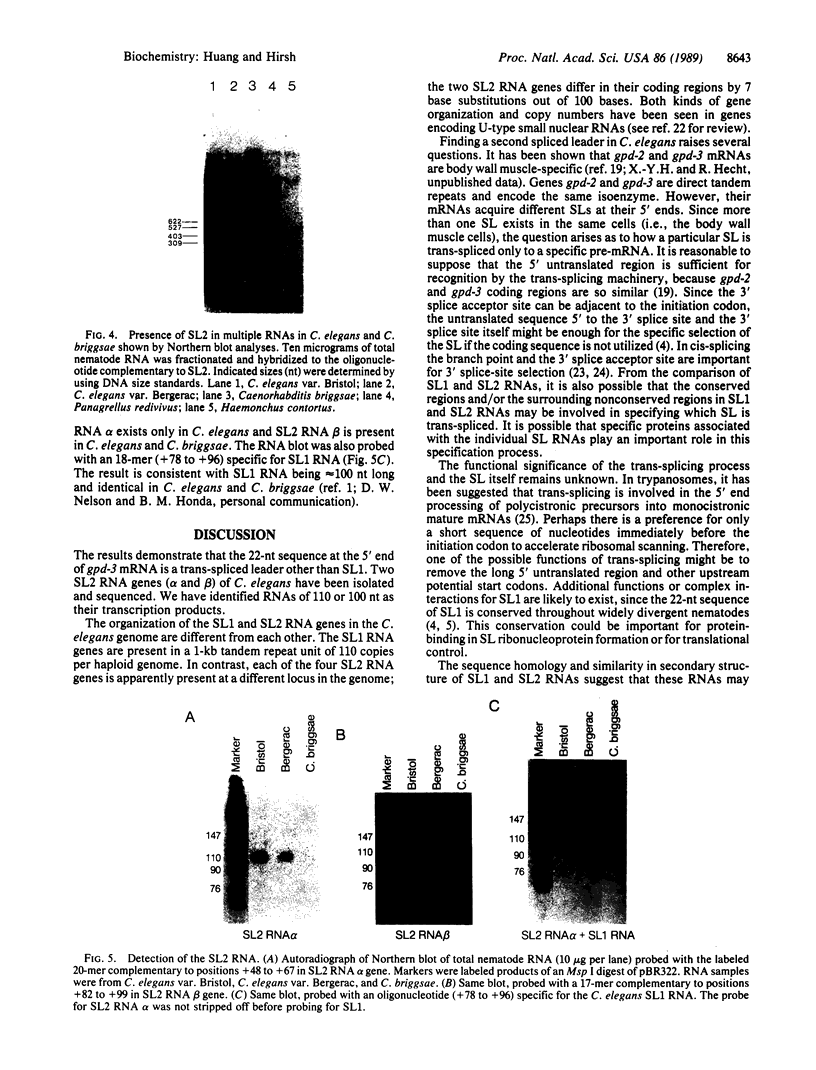
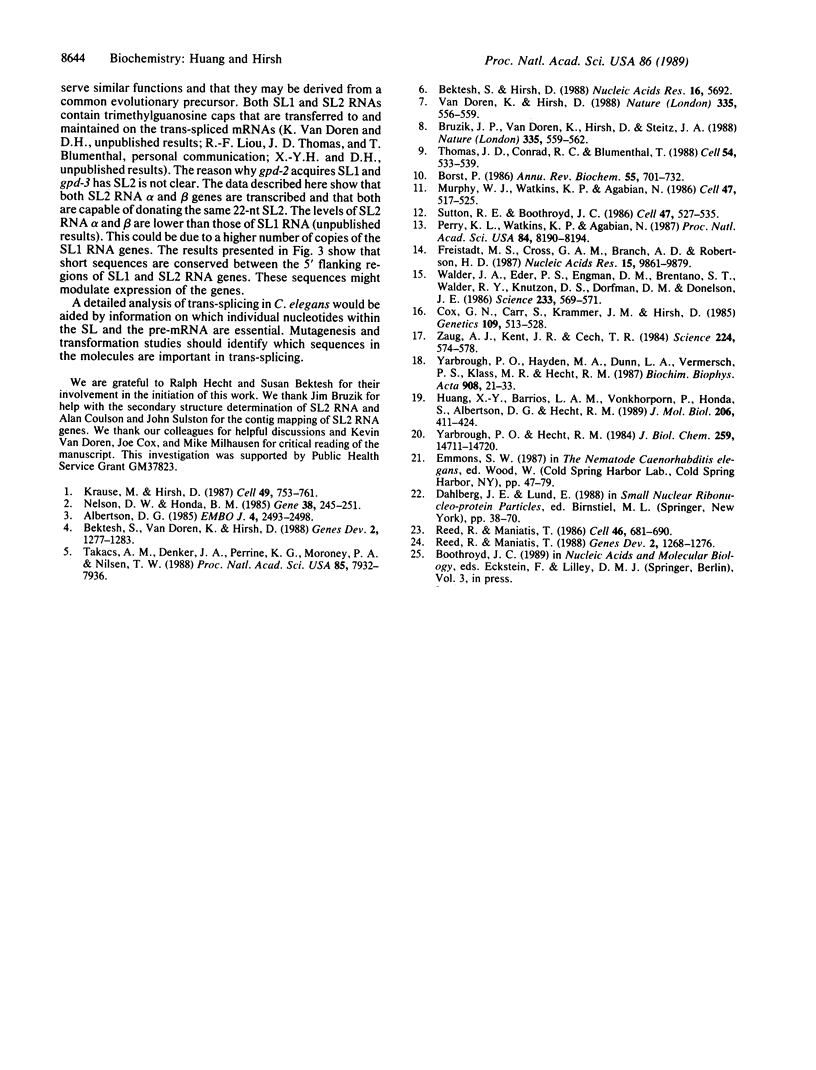
Images in this article
Selected References
These references are in PubMed. This may not be the complete list of references from this article.
- Albertson D. G. Mapping muscle protein genes by in situ hybridization using biotin-labeled probes. EMBO J. 1985 Oct;4(10):2493–2498. doi: 10.1002/j.1460-2075.1985.tb03961.x. [DOI] [PMC free article] [PubMed] [Google Scholar]
- Bektesh S. L., Hirsh D. I. C. elegans mRNAs acquire a spliced leader through a trans-splicing mechanism. Nucleic Acids Res. 1988 Jun 24;16(12):5692–5692. doi: 10.1093/nar/16.12.5692. [DOI] [PMC free article] [PubMed] [Google Scholar]
- Bektesh S., Van Doren K., Hirsh D. Presence of the Caenorhabditis elegans spliced leader on different mRNAs and in different genera of nematodes. Genes Dev. 1988 Oct;2(10):1277–1283. doi: 10.1101/gad.2.10.1277. [DOI] [PubMed] [Google Scholar]
- Borst P. Discontinuous transcription and antigenic variation in trypanosomes. Annu Rev Biochem. 1986;55:701–732. doi: 10.1146/annurev.bi.55.070186.003413. [DOI] [PubMed] [Google Scholar]
- Bruzik J. P., Van Doren K., Hirsh D., Steitz J. A. Trans splicing involves a novel form of small nuclear ribonucleoprotein particles. Nature. 1988 Oct 6;335(6190):559–562. doi: 10.1038/335559a0. [DOI] [PubMed] [Google Scholar]
- Cox G. N., Carr S., Kramer J. M., Hirsh D. Genetic mapping of Caenorhabditis elegans collagen genes using DNA polymorphisms as phenotypic markers. Genetics. 1985 Mar;109(3):513–528. doi: 10.1093/genetics/109.3.513. [DOI] [PMC free article] [PubMed] [Google Scholar]
- Freistadt M. S., Cross G. A., Branch A. D., Robertson H. D. Direct analysis of the mini-exon donor RNA of Trypanosoma brucei: detection of a novel cap structure also present in messenger RNA. Nucleic Acids Res. 1987 Dec 10;15(23):9861–9879. doi: 10.1093/nar/15.23.9861. [DOI] [PMC free article] [PubMed] [Google Scholar]
- Huang X. Y., Barrios L. A., Vonkhorporn P., Honda S., Albertson D. G., Hecht R. M. Genomic organization of the glyceraldehyde-3-phosphate dehydrogenase gene family of Caenorhabditis elegans. J Mol Biol. 1989 Apr 5;206(3):411–424. doi: 10.1016/0022-2836(89)90490-7. [DOI] [PubMed] [Google Scholar]
- Krause M., Hirsh D. A trans-spliced leader sequence on actin mRNA in C. elegans. Cell. 1987 Jun 19;49(6):753–761. doi: 10.1016/0092-8674(87)90613-1. [DOI] [PMC free article] [PubMed] [Google Scholar]
- Murphy W. J., Watkins K. P., Agabian N. Identification of a novel Y branch structure as an intermediate in trypanosome mRNA processing: evidence for trans splicing. Cell. 1986 Nov 21;47(4):517–525. doi: 10.1016/0092-8674(86)90616-1. [DOI] [PubMed] [Google Scholar]
- Nelson D. W., Honda B. M. Genes coding for 5S ribosomal RNA of the nematode Caenorhabditis elegans. Gene. 1985;38(1-3):245–251. doi: 10.1016/0378-1119(85)90224-0. [DOI] [PubMed] [Google Scholar]
- Perry K. L., Watkins K. P., Agabian N. Trypanosome mRNAs have unusual "cap 4" structures acquired by addition of a spliced leader. Proc Natl Acad Sci U S A. 1987 Dec;84(23):8190–8194. doi: 10.1073/pnas.84.23.8190. [DOI] [PMC free article] [PubMed] [Google Scholar]
- Reed R., Maniatis T. A role for exon sequences and splice-site proximity in splice-site selection. Cell. 1986 Aug 29;46(5):681–690. doi: 10.1016/0092-8674(86)90343-0. [DOI] [PubMed] [Google Scholar]
- Reed R., Maniatis T. The role of the mammalian branchpoint sequence in pre-mRNA splicing. Genes Dev. 1988 Oct;2(10):1268–1276. doi: 10.1101/gad.2.10.1268. [DOI] [PubMed] [Google Scholar]
- Sutton R. E., Boothroyd J. C. Evidence for trans splicing in trypanosomes. Cell. 1986 Nov 21;47(4):527–535. doi: 10.1016/0092-8674(86)90617-3. [DOI] [PMC free article] [PubMed] [Google Scholar]
- Takacs A. M., Denker J. A., Perrine K. G., Maroney P. A., Nilsen T. W. A 22-nucleotide spliced leader sequence in the human parasitic nematode Brugia malayi is identical to the trans-spliced leader exon in Caenorhabditis elegans. Proc Natl Acad Sci U S A. 1988 Nov;85(21):7932–7936. doi: 10.1073/pnas.85.21.7932. [DOI] [PMC free article] [PubMed] [Google Scholar]
- Thomas J. D., Conrad R. C., Blumenthal T. The C. elegans trans-spliced leader RNA is bound to Sm and has a trimethylguanosine cap. Cell. 1988 Aug 12;54(4):533–539. doi: 10.1016/0092-8674(88)90075-x. [DOI] [PubMed] [Google Scholar]
- Van Doren K., Hirsh D. Trans-spliced leader RNA exists as small nuclear ribonucleoprotein particles in Caenorhabditis elegans. Nature. 1988 Oct 6;335(6190):556–559. doi: 10.1038/335556a0. [DOI] [PubMed] [Google Scholar]
- Walder J. A., Eder P. S., Engman D. M., Brentano S. T., Walder R. Y., Knutzon D. S., Dorfman D. M., Donelson J. E. The 35-nucleotide spliced leader sequence is common to all trypanosome messenger RNA's. Science. 1986 Aug 1;233(4763):569–571. doi: 10.1126/science.3523758. [DOI] [PubMed] [Google Scholar]
- Yarbrough P. O., Hayden M. A., Dunn L. A., Vermersch P. S., Klass M. R., Hecht R. M. The glyceraldehyde-3-phosphate dehydrogenase gene family in the nematode, Caenorhabditis elegans: isolation and characterization of one of the genes. Biochim Biophys Acta. 1987 Jan 28;908(1):21–33. doi: 10.1016/0167-4781(87)90018-2. [DOI] [PubMed] [Google Scholar]
- Yarbrough P. O., Hecht R. M. Two isoenzymes of glyceraldehyde-3-phosphate dehydrogenase in Caenorhabditis elegans. Isolation, properties, and immunochemical characterization. J Biol Chem. 1984 Dec 10;259(23):14711–14720. [PubMed] [Google Scholar]
- Zaug A. J., Kent J. R., Cech T. R. A labile phosphodiester bond at the ligation junction in a circular intervening sequence RNA. Science. 1984 May 11;224(4649):574–578. doi: 10.1126/science.6200938. [DOI] [PubMed] [Google Scholar]



